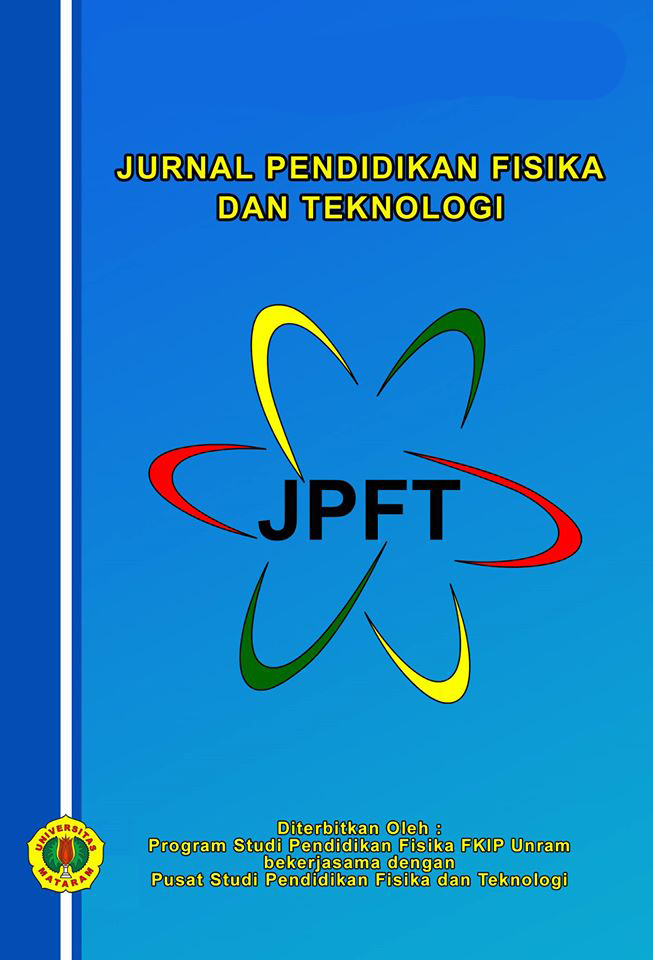Kafah Science Test Model to Improve the Quality of Prospective Teachers
DOI:
10.29303/jpft.v9i1.5028Published:
2023-06-24Issue:
Vol. 9 No. 1 (2023): January - JuneKeywords:
Kafah, Prospective Physics Teacher, Kafah science testArticles
Downloads
How to Cite
Downloads
Metrics
Abstract
This research aims to create and analyze a comprehensive science question model (Science Kafah) to enhance the quality of prospective teachers. The quality of prospective teachers refers to their comprehensive abilities in a specific science subject being taught. These abilities encompass conceptual understanding, religious connections, application, and meaningfulness. The research instrument consists of Science Kafah questions with various developed models. The analysis is conducted on the question models and individual items to assess validity, reliability, discrimination power, and difficulty index. The research findings reveal that the Science Kafah question model consists of 1) questions measuring conceptual understanding, 2) questions measuring religious abilities, 3) questions measuring application skills, 4) questions measuring meaningfulness, and 5) questions measuring social skills. Analysis of the instrument shows that out of the 25 tested questions, 20% were deemed inadequate, while 80% met the criteria for good questions. The Science Kafah question model can assess comprehensive abilities in science, its connection to religion, application skills (technology, engineering, environment, arts, and mathematics), and the meaningfulness of the taught concepts.
References
Abidin,Y. (2014). Desain Sistem Pembelajaran dalam Konteks Kurikulum 2013. Bandung: PT Refika Adiatama
Agus, P. (2015). Ayat-ayat Semesta (Sisi-sisi al-Quran yang Terlupakan). PT. Mizan Pustaka.
Anggraeni, P. (2018). Analisis keterkaitan antar komponen dalam rencana pelaksanaan pembelajaran di Sekolah Dasar Kota Sumedang. El-Ibtidaiy: Journal of Primary Education, 1(1), 64-71. DOI: http://dx.doi.org/10.24014/ejpe.v1i1.5069
Arikunto. (2011). Dasar-Dasar Evaluasi Pendidikan. Jakarta: PT Bumi Aksara.
Asyhari, A. (2019). Pengembangan instrumen asesmen literasi sains berbasis nilai-nilai islam dan budaya indonesia dengan pendekatan kontekstual. Lentera Pendidikan: Jurnal Ilmu Tarbiyah Dan Keguruan, 22(1), 166-179. https://doi.org/10.24252/lp.2019v22n1i14
Fatimah, L. U., & Alfath, K. (2019). Analisis kesukaran soal, daya pembeda dan fungsi distraktor. AL-MANAR: Jurnal Komunikasi dan Pendidikan Islam, 8(2), 37-64. DOI: https://doi.org/10.36668/jal.v8i2.115
Hassan, A., Suhid, A., Abiddin, N. Z., Ismail, H., & Hussin, H. (2010). The role of Islamic philosophy of education in aspiring holistic learning. Procedia-Social and Behavioral Sciences, 5, 2113-2118.
Hidayat, R. (2015). Berani bicara pendidikan. Jakarta: Unpak.
Ibrahim, M. (2000). Problem Based Learning. Surabaya: University Press.
Lidiana, H., Gunawan, G., & Taufik, M. (2018). Pengaruh Model Discovery Learning Berbantuan Media PhET Terhadap Hasil Belajar Fisika Peserta Didik Kelas XI SMAN 1 Kediri Tahun Ajaran 2017/2018. Jurnal Pendidikan Fisika Dan Teknologi, 4(1), 33–39. https://doi.org/10.29303/jpft.v4i1.519
Murfiah, U. (2017). Model pembelajaran terpadu di Sekolah Dasar. Jurnal Pesona Dasar, 1(1).
Muslih, M. (2017). Rekonstruksi Metodologi Pengembangan Sains Berbasis Agama. KALAM, 11(2), 267-298. DOI: http://dx.doi.org/10.24042/klm.v11i2.1795
Muspiroh, N. (2014). Integrasi nilai-nilai islam dalam pembelajaran IPA di sekolah. Quality, 2(1), 168-188.
Muthoharoh, M. (2020). Inovasi pembelajaran pendidikan agama islam berbasis hots (higher order thinking skill). JIE (Journal of Islamic Education), 5(2), 131-143. https://www.ejournal.stitmuhbangil.ac.id/index.php/jie/article/view/181/108
Orion, N. (2007). A Holistic Approach for Science Education For All. Eurasia Journal of Mathematics, Science and Technology Education, 3(2), 111-118. https://doi.org/10.12973/ejmste/75382
Rifai, M. (2011). Politik Pendidikan Nasional. Yogyakarta: ArRuz Media
Rohman, S. (2016). Filsafat Pendidikan Masa Depan. Yogyakarta: Pustaka Pelajar.
Sani, R. A. (2016). Penilaian Autentik. Jakarta: PT Bumi Aksara
SEQIP. (2010). Asesmen Autentik. Jakarta: Depdiknas
Suarta, I. N., & Rahayu, D. I. (2018). Model pembelajaran holistik integratif di paud untuk mengembangkan potensi dasar anak usia dini. Jurnal Ilmiah Profesi Pendidikan, 3(1).
Sudijono, A. (2006). Pengantar Evaluasi Pendidikan, Jakarta: PT Raja Grafindo Persada.
Sugiyono. (2017). Qualitative Quantitative Research Methods and R & D. Bandung: Alfabeta.
Suparno, S. (2022). Muslim Kafah-1 dalam Persepsi Saintis. Bandung: ITB Press.
Suryani, I. (2016). Pengembangan instrumen penilaian sikap ilmiah pada pembelajaran dengan model latihan penelitian di sekolah dasar. PEDADIDAKTIKA: Jurnal Ilmiah Pendidikan Guru Sekolah Dasar, 3(2), 217-227. DOI: https://doi.org/10.17509/pedadidaktika.v3i2.5152
Susanna. (2020). Analisis Tingkat Kesulitan Soal Try Out Fisika SMA Negeri 5 Banda Aceh, Jurnal Pendidikan Fisika dan Teknologi (JPFT), 6(2), 193-197, from http://dx.doi.org/10.29303/jpft.v6i2.1457
Swary, D. U. (2020). Fisika Kuantum: Jembatan antara Sains dan Spiritualitas.
Syahrial, A., Sarjan, M., Rokhmat, J., Arizona, K., Sucilestari, R., Syahidi, K., ... & Mertha, I. G. (2022). Model Pembelajaran IPA Secara Kafah. ORBITA: Jurnal Kajian, Inovasi dan Aplikasi Pendidikan Fisika, 8(1), 154-159. DOI: https://doi.org/10.31764/orbita.v8i1.8573
Author Biographies
Syahrial Ayub, University of Mataram
Physics Education Study Program
Joni Rokhmat, University of Mataram
Science Education Master Program
Ahmad Busyairi, University of Mataram
Physics Education Study Program
Gusti Afifah, SMAN 2 Mataram
Physics Teacher in Senior High School 2 Mataram
License
Copyright (c) 2023 Syahrial Ayub, Joni Rokhmat, Ahmad Busyairi, Gusti Afifah

This work is licensed under a Creative Commons Attribution-ShareAlike 4.0 International License.
Authors who publish with Jurnal Pendidikan Fisika dan Teknologi (JPFT) agree to the following terms:
- Authors retain copyright and grant the journal right of first publication with the work simultaneously licensed under a Creative Commons Attribution License 4.0 International License (CC-BY-SA License). This license allows authors to use all articles, data sets, graphics, and appendices in data mining applications, search engines, web sites, blogs, and other platforms by providing an appropriate reference. The journal allows the author(s) to hold the copyright without restrictions and will retain publishing rights without restrictions.
- Authors are able to enter into separate, additional contractual arrangements for the non-exclusive distribution of the journal's published version of the work (e.g., post it to an institutional repository or publish it in a book), with an acknowledgement of its initial publication in Jurnal Pendidikan Fisika dan Teknologi (JPFT).
- Authors are permitted and encouraged to post their work online (e.g., in institutional repositories or on their website) prior to and during the submission process, as it can lead to productive exchanges, as well as earlier and greater citation of published work (See The Effect of Open Access).











